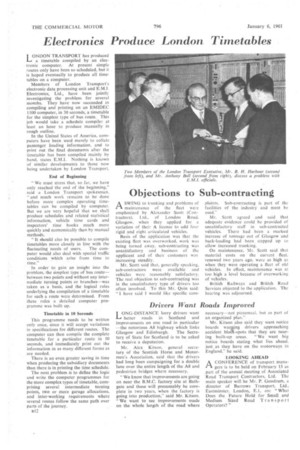Electronics Produce London Timetables
Page 46

If you've noticed an error in this article please click here to report it so we can fix it.
ONDON TRANSPORT has produced LA a timetable compiled by an electronic computer. At present simple routes only have been so scheduled, but it is hoped eventually to produce all timetables on a computer.
Members of London Transport's electronic data processing unit and E.M.I. Electronics, Ltd., have been jointly investigating the problem for several months. They have now succeeded in compiling and printing on an EMIDEC 1100 computer, in 30 seconds, a timetable for the simplest type of bus route. This job would take a schedule compiler at least an hour to produce manually in rough outline.
In the United States of America, computers have been used merely to collate passenger loading information, and to print out the final documents after the timetable has been compiled mainly by hand, states E.M.1. Nothing is known of similar developments to those now being undertaken by London Transport.
End of Beginning " We must stress that, so far, we have only reached the end of the beginning," said a London Transport spokesman. " and much work remains to be done before more complex operating timetables can be compiled by computer. But we are very hopeful that we shall produce schedules and related statistical information, vehicle time cards and inspectors' time books much more quickly and economically than by manual methods.
"It should also be possible to compile timetables more closely in line with the
fluctuating needs of users. The computer would also deal with special traffic conditions which arise from time to time."
In order to gain an insight into the problem, the simplest type of bus route— between two points and without any intermediate turning points or branches—was taken as a basis, and the logical rules underlying the compilation of a timetable for such a route were determined. From these rules a detailed computer programme was built up.
Timetable in 10 Seconds This programme needs to be written only once, since it will accept variations in specifications for different routes. The computer can then compile the complete timetable for a particular route in 10 seconds, and immediately print out the information in as many different forms as are needed.
There is an even greater saving in time when producing the subsidiary documents than there is in printing the time schedule.
The next problem is to define the logic and write the computer programmes for the more complex types of timetable, comprising several intermediate turning points, two or more garage allocations, and inter-working requirements where several routes follow the same path over parts of the journey.
B 2




















































































































